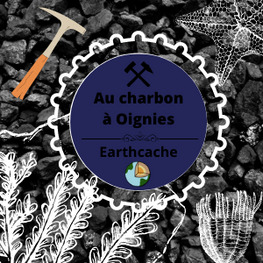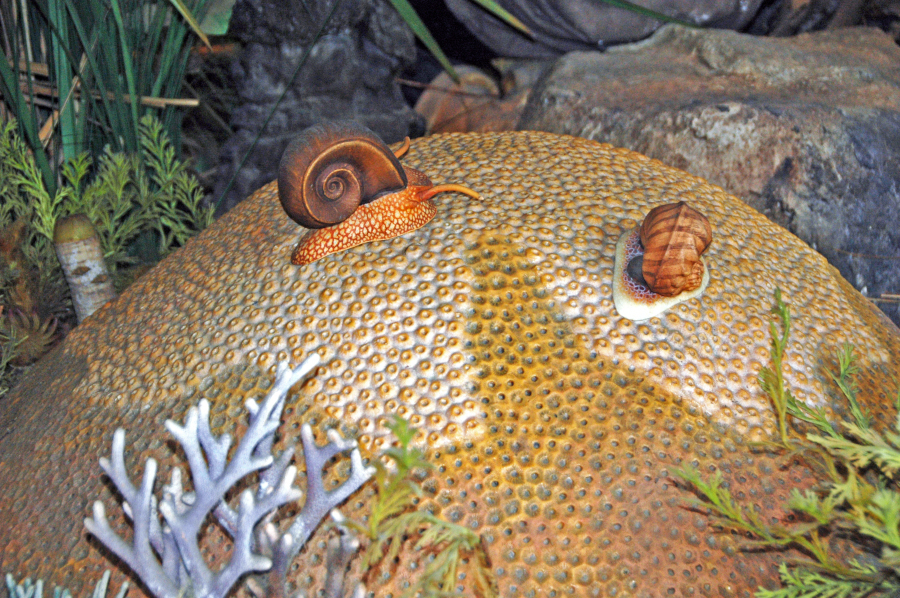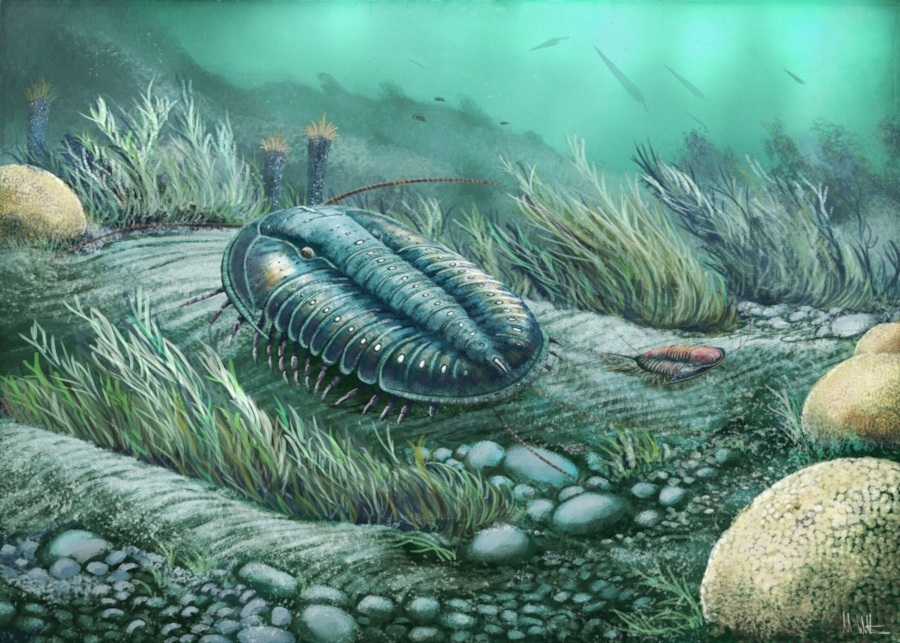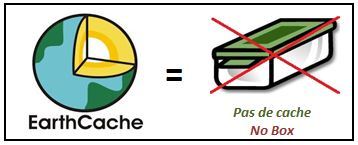

Cette cache a été posée à l'occasion du Mega évent "Au Charbon" à Oignies GC9XH0Z. Ce rassemblement a été voulu par les organisateurs comme un moment de convivalité entre passionés de Geocaching, de nature et de patrimoine. Notre volonté est de permettre à chaque profil de joueur de pouvoir pratiquer ce loisir comme il le souhaite et de partager avec d'autres des moments de rassemblement et de partage autour d'un site emblématique du bassin minier du Pas-de-Calais : Le carreau de fosse du 9-9bis de Oignies.
Il y a 350 millions d'années...
Cette Earth Cache a pour but de vous faire découvrir quelques fossiles de 350 millions d'années.
Horaires d'ouverture: du 1er avril au 1er novembre: de 8h à 18h / du 2 novembre au 31 mars: de 8h à 17h.
L'étage du Tournaisien
Le Tournaisien est le premier étage géologique du Mississippien dans le Carbonifère (ère Paléozoïque) qui s'étend de 360 à 348 millions d'années. Il doit son nom à la ville de Tournai en Belgique.
Echelle géologique globale. 🔽

Contexte géologique
A la fin du Dévonien, une extinction massive frappe les écosystèmes: 75 % des espèces connues disparaissent. L'extinction se situe entre environ 380 et 360 millions d'années, avec trois épisodes principaux. Ce sont essentiellement les espèces marines qui sont touchées : récifs, brachipodes, organismes benthiques. Les poissons sans dent (agnathes) disparaissent, ainsi que de nombreux autres groupes de poissons appartenant aux placodermes (poissons cuirassés), acanthodiens.
Malgré tout, la reconquête des nouveaux environnements marins est rapide à l’exception des faciès récifaux qui ont été décimés et ne persistent tout d’abord que sous forme de stromatolites: c'est le début du Carbonifère, et également du Tournaisien.
Paléogéographie
En Belgique, le Tournaisien et le Viséen (l'étage géologique suivant) sont caractérisés par une sédimentation carbonatée marine. Une plate-forme carbonatée (ou plateau) s'installe sur la bordure méridionale du Massif du Brabant (terres émergées). L'aplanissement des reliefs calédoniens situés au nord et un climat aride limitent l'arrivée de sédiments terrigènes et permettent le démarrage de ce que l'on appelle souvent l'"usine à carbonates".
Localisation du plateau continental. 🔽

La pierre bleue de Belgique
Le Tournaisien de la région voit l'accumulation de plus de 300 m de calcaires surtout crinoïdiques qui font aujourd'hui la richesse du bassin carrier.
La pierre bleue de Belgique est un calcaire compact résultant de l’accumulation, en mer peu profonde et chaude, de nombreux fossiles dans une boue carbonatée. Le principal fossile de la pierre bleue de Belgique est sans conteste le crinoïde dont les articles (segments cylindriques) forment l’essentiel de la roche. Sur les fonds marins, les colonies de cet échinoderme formaient de véritables « prairies » où des coraux, des coquillages (brachiopodes, mollusques, gastéropodes...) et d'autres organismes trouvèrent un milieu de vie favorable.
Les gisements de pierre bleue de Belgique se composent de bancs pluridécimétriques à métriques portant chacun une dénomination particulière . Ces bancs sont compacts, de teinte gris-bleu à gris-noir.
Paléoécologie
Les fonds marins du Tournaisien présentent de nombreux organismes, comme le montre cette reconstitution de l'environnement.
Ecosystème du Tournaisien. 🔽

- Crinozoa (crinoïdes): 1, 2, 6, 12
- Echinoidea (oursins): 13
- Brachiopoda (brachiopodes): 3,16
- Bryozoa (bryozoaires): 4, 10
- Gastropoda (gastéropodes): 5
- Chondrichthyes (poissons cartilagineux): 7
- Cephalopoda (céphalopodes): 8
- Anthozoa (anthozoaires, ou coraux): 9, 11, 15
- Trilobita (trilobites): 14
Les organismes fossiles les plus courants
Crinozoa (crinoïdes)
Ces organismes ont un mode de vie benthique, ils sont souvent fixés mais certains peuvent se déplacer sur le fond. Ils sont suspensivores et collectent des particules alimentaires grâce à leurs longs bras munis de cils.
Crinoïde actuel. 🔽

Crinoïdes fossiles. 🔽

Brachiopoda (brachiopodes)
Les brachiopodes sont des animaux marins. Ils ont connu un grand succès évolutif au Paléozoïque, où ils furent extrêmement abondants et diversifiés, laissant une grande quantité de fossiles. Il n'en existe plus aujourd'hui que 460 espèces à peine, relativement discrètes. Les brachiopodes sont des animaux extrêmement anciens et relativement archaïques.
Reconstitution d'un brachiopode. 🔽

Brachiopode du genre Leptaena. 🔽

Brachiopode du genre Spirifer. 🔽

Bryozoa (bryozoaires)
Ce sont des animaux coloniaux et sessiles. Ces métazoaires forment un groupe apparu à l'Ordovicien. Chaque individu, appelé zoïde ou zoécie, forme une petite loge chitineuse et vit le plus souvent fixé au sein d'une colonie, le zoarium. La plupart des espèces produisent une matière carbonatée qui constitue ces loges, et plusieurs espèces contribuent à la construction des récifs coralliens.
Bryozoaire actuel. 🔽

Bryozoaire du genre Fenestella. 🔽

Gastropoda (gastéropodes)
C'est une classe de mollusques caractérisés par la torsion de leur masse viscérale. Ils présentent une très grande diversité de formes mais peuvent se reconnaitre généralement par leur coquille dorsale torsadée et univalve caractéristique. Ils possèdent un pied et une tête distincts. Leur pied est aplati en une large sole ventrale, servant à la natation ou la reptation, tandis que leur tête comporte des yeux.
Reconstitution d'un gastéropode. 🔽

Gastéropode du genre Straparollus. 🔽

Cephalopoda (céphalopodes)
C'est une classe de mollusques apparus à la fin du Cambrien (500 millions d'années) dont la tête est munie de tentacules. Ce nom générique inclut notamment les pieuvres, calmars et seiches, et les nautiles. Environ 800 espèces vivantes sont connues et de nouvelles espèces continuent d'être décrites. Environ 11 000 genres ou espèces éteints ont été décrits.
Illustration d'un céphalopode. 🔽

Cephalopode de la famille des Actinocerida. 🔽

Anthozoa (anthozoaires, ou coraux)
Les coraux une classe de Cnidaires, comprenant notamment les coraux et les anémones de mer. Ce sont des polypes qui se reproduisent, émettant des gamètes qui, après fécondation, donnent des larves planula planctoniques qui assurent la dissémination de l'espèce. Certains Anthozoaires se reproduisent aussi par multiplication asexuée ce qui peut produire de grandes colonies.
Reconstitution de coraux solitaires. 🔽

Petit corail rugueux solitaire du genre Cyathaxonia. 🔽

Gros corail rugueux solitaire du genre Caninophyllum. 🔽

Illustration d'un corail tabulaire massif. 🔽

Corail tabulaire massif du genre Michelinia. 🔽

Trilobita (trilobites)
C'est une classe d'arthropodes marins fossiles ayant existé durant le Paléozoïque (ère primaire) du Cambrien au Permien. Les derniers trilobites ont disparu lors de l'extinction de masse à la fin du Permien, il y a 250 Ma. Les trilobites variaient en taille, entre 1 millimètre et environ 70 cm de long. Bien connus, ils sont très abondants dans les roches datant de l'ère primaire. Plus de 18 750 espèces ont été décrites dans cette classe d'arthropodes, ce qui en fait l'un des groupes exclusivement fossiles les plus diversifiés.
Illustration d'un trilobite. 🔽

Trilobite du genre Cummingella. 🔽

Sources
Comment valider cette Earth Cache
Petit rappel concernant les "Earth Caches": il n'y a pas de contenant à rechercher, ni de logbook. Il suffit de se rendre sur les lieux, de répondre aux questions ci-dessous. Vous pouvez loger en "Found it" et envoyez-moi vos propositions de réponses, soit via mon profil, soit via la messagerie geocaching.com (Message Center), et je vous contacterai en cas de problème.

Localisation
Lorsque vous êtes devant le buste d'André Pantigny, faites en le tour et observez la roche.


Questions
- 1: quelles étaient les trois principales caractéristiques environnementales au Tournaisien en Belgique?
- 2a: dans la zone A, quels sont les organismes présents? Hormis le fait qu'ils soient vus en coupes, sont-ils complets?
- 2b: dans la zone B, il y a deux organismes, que sont-ils (nommez les)? Font-ils partie du même embranchement?
- 2c: dans la zone C, vous pouvez observer plusieurs organismes fossiles de forme plus ou moins arrondie, et seuls trois d'entre eux sont complets; de quelle embranchement font-ils partie? Combien de types différents observez-vous, et décrivez les sommairement.
- 3: une photo de vous ou d'un objet vous représentant, est obligatoire pour valider cette Earth Cache.
Merci par avance de ne pas poster de spoiler dans vos logs!
Bon Geocaching!


This cache was placed during the Mega vent "Au Charbon" in Oignies GC9XH0Z. This gathering was wanted by the organizers as a moment of conviviality between enthusiasts of geocaching, nature and heritage. The desire is to allow each profile of player to be able to practice this leisure as he wishes and to share with others moments of gathering and sharing around an emblematic site of the mining basin of Pas-de-Calais: the pit tile of 9-9bis of Oignies.
350 million years ago...
This Earth Cache aims to show you some 350 million year old fossils.
Opening hours: 1 April to 1 November: 8 am to 6 pm / 2 November to 31 March: 8 am to 5 pm.
The Tournaisian stage
The Tournaisian is the first geological stage of the Mississippian in the Carboniferous (Paleozoic era) which extends from 360 to 348 million years ago. It is named after the city of Tournai in Belgium.
Global geological scale. 🔽

Geological background
At the end of the Devonian period, a mass extinction hit the ecosystems: 75% of known species disappeared. The extinction occurred between about 380 and 360 million years ago, with three main episodes. It was mainly marine species that were affected: reefs, brachipods and benthic organisms. Toothless fish (agnathans) disappeared, as did many other groups of fish belonging to the placoderms (armoured fish), acanthodians.
Despite this, the reconquest of the new marine environments was rapid, with the exception of the reef facies, which were decimated and initially persisted only in the form of stromatolites: this was the beginning of the Carboniferous, and also the Tournaisian.
Palaeogeography
In Belgium, the Tournaisian and Viséan (the next geological stage) are characterised by marine carbonate sedimentation. A carbonate platform was established on the southern edge of the Brabant Massif (land area). The flattening of the Caledonian reliefs to the north and an arid climate limit the arrival of terrigenous sediments and allow the start of what is often called the "carbonate factory".
Location of the continental shelf. 🔽

Belgian bluestone
The Tournaisian period of the region saw the accumulation of more than 300 m of mainly crinoid limestone, which is the richness of the quarry basin today.
Belgian bluestone is a compact limestone resulting from the accumulation of numerous fossils in a carbonate mud in a shallow, warm sea. The most important fossil in Belgian bluestone is undoubtedly the crinoid, whose articles (cylindrical segments) form the bulk of the rock. On the seabed, the colonies of this echinoderm formed real 'meadows' where corals, shellfish (brachiopods, molluscs, gastropods, etc.) and other organisms found a favourable living environment.
The Belgian bluestone deposits consist of multi-decimetre to metric benches, each with a specific name. These benches are compact, with a grey-blue to grey-black colour.
Palaeoecology
The Tournaisian seabed contains many organisms, as shown in this environmental reconstruction.
The Tournaisian Ecosystem. 🔽

- Crinozoa (crinoids): 1, 2, 6, 12
- Echinoidea (sea urchins): 13
- Brachiopoda (brachiopods): 3,16
- Bryozoa (bryozoans): 4, 10
- Gastropoda (gastropods): 5
- Chondrichthyes (cartilaginous fishes): 7
- Cephalopoda (cephalopods): 8
- Anthozoa (anthozoans, or corals): 9, 11, 15
- Trilobita (trilobites): 14
Most common fossil organisms
Crinozoa (crinoids)
These organisms have a benthic way of life, they are often fixed but some can move on the bottom. They are suspension feeders and collect food particles with their long ciliated arms.
Present-day Crinoid. 🔽

Fossil crinoids. 🔽

Brachiopoda (brachiopods)
Brachiopods are marine animals. They had a great evolutionary success in the Paleozoic, where they were extremely abundant and diversified, leaving a large quantity of fossils. Today, there are only 460 relatively discrete species. Brachiopods are extremely ancient and relatively archaic animals.
Reconstitution of a brachiopod. 🔽

Brachiopod of the genus Leptaena. 🔽

Brachiopod of the genus Spirifer. 🔽

Bryozoa (bryozoans)
They are colonial and sessile animals. These metazoans form a group that appeared in the Ordovician period. Each individual, called a zoid or zoecium, forms a small chitinous lodge and usually lives in a colony, the zoarium. Most species produce a carbonate material that forms these lodges, and several species contribute to the construction of coral reefs.
Current Bryozoan. 🔽

Bryozoan of the genus Fenestella. 🔽

Gastropoda (gastropods)
This is a class of molluscs characterised by the twisting of their visceral mass. They come in a wide variety of shapes but can generally be recognised by their characteristic twisted, univalved dorsal shell. They have a distinct foot and head. Their foot is flattened into a broad ventral sole, used for swimming or crawling, while their head has eyes.
Reconstitution of a gastropod. 🔽

Gastropod of the genus Straparollus. 🔽

Cephalopoda (cephalopods)
A class of molluscs that appeared at the end of the Cambrian period (500 million years ago) and have tentacles on their heads. This generic name includes octopuses, squid and cuttlefish, and nautilus. About 800 living species are known and new species continue to be described. About 11,000 extinct genera or species have been described.
Illustration of a cephalopod. 🔽

Cephalopod of the family Actinocerida. 🔽

Anthozoa (anthozoans, or corals)
Corals a class of Cnidaria, including corals and sea anemones. They are polyps that reproduce, emitting gametes which, after fertilisation, give planktonic larvae that ensure the dissemination of the species. Some Anthozoa also reproduce by asexual multiplication which can produce large colonies.
Reconstitution of solitary corals. 🔽

Small solitary rugose coral of the genus Cyathaxonia. 🔽

Large solitary rugose coral of the genus Caninophyllum. 🔽

Illustration of a massive tabular coral. 🔽

Massive tabular coral of the genus Michelinia. 🔽

Trilobita (trilobites)
It is a class of fossil marine arthropods that existed during the Paleozoic (primary era) from Cambrian to Permian. The last trilobites disappeared during the mass extinction at the end of the Permian, 250 Ma ago. Trilobites ranged in size from 1 millimetre to about 70 cm long. They are well known and very abundant in rocks from the Primary Era. More than 18,750 species have been described in this class of arthropods, making it one of the most diverse exclusively fossil groups.
Illustration of a trilobite. 🔽

Trilobite of the genus Cummingella. 🔽

Sources
How to validate this Earth Cache
A reminder about the "Earth Caches": there is no container to look for, nor a logbook. You just have to go to the place and answer the questions below. You can log in "Found it" and send me your suggestions for answers, either via my profile, or via the geocaching.com message center, and I will contact you if there is a problem.

Location
When you are in front of the bust of André Pantigny, walk around it and look at the rock.


Questions
- 1: what were the three main environmental characteristics in Tournaisian in Belgium?
- 2a: in area A, what organisms are present? Apart from the fact that they are seen in sections, are they complete?
- 2b: in area B there are two organisms, what are they (name them)? Are they part of the same phylum?
- 2c: in area C you can see several more or less round-shaped fossil organisms, and only three of them are complete; which phylum do they belong to? How many different types do you see, and describe them briefly.
- 3: a photo of you or an object representing you is mandatory to validate this Earth Cache.
Thank you in advance for not posting spoilers in your logs!
Happy Geocaching!
